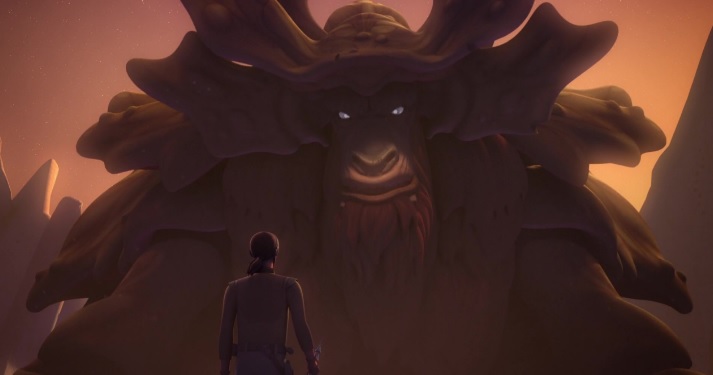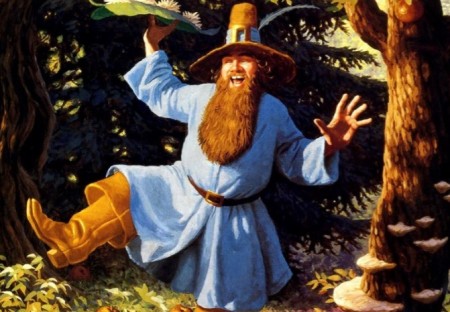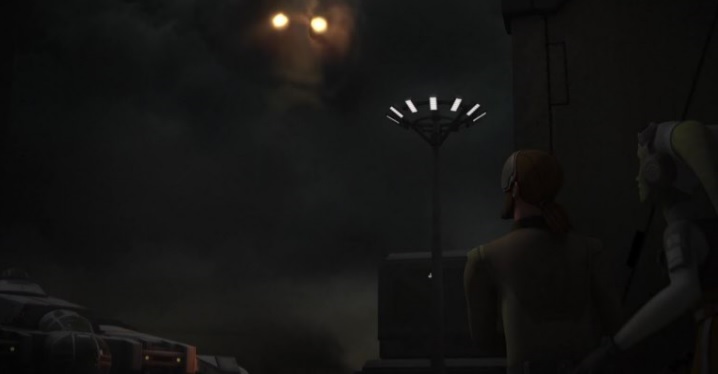
Comparing anything in the Star Wars galaxy to the works of JRR Tolkien is a tricky business, and one we should be cautious of. Though George Lucas did once cite The Lord of the Rings as an influence, thematically they are very different works, and Tolkien and Lucas drew their core inspirations from very different places. When it comes to Dave Filoni’s work on The Clone Wars and Rebels, though, the situation is a little different.
Filoni is a self-confessed Tolkien fanboy, who has talked often of the professor’s influence on his work. He even gave Ahsoka some of Gandalf’s lines in Rebels season two (“I have questions – questions that need answering”), as Ahsoka dropped in and out of the story as the old wizard does in The Hobbit. In a recent interview with Fangirls Going Rogue, Filoni revealed that his main influence when creating the character of Bendu for season three was in fact the notorious Tom Bombadil from The Fellowship of the Ring.
Bendu is generating a great deal of interest as the internet struggles to decipher Luke Skywalker’s cryptic words in the trailer for The Last Jedi. Bendu does, after all, claim to be “the one in the middle,” a new perspective on the Force. Attempts to argue that the character is a sign that Lucasfilm are laying the groundwork for a more “grey” approach, however, risk clouding the true meaning of the character, and overlooking some unsettling truths about him. For a fuller understanding, it helps to look at the character of Bombadil, and work towards Bendu from there.
In the House of Tom Bombadil
Tom Bombadil has become a bit of a running joke in popular culture. It is a passage of LotR that many readers struggle with due to his incessant singing and apparent irrelevance to the story. In this section of the book, the four hobbits are attacked by a tree called Old Man Willow. They are saved by Bombadil, a jolly old man who takes them home to meet his wife Goldberry, gives them a bed for the night, sings a bit, and then sends them on their way. None of this made it into the Peter Jackson film adaptations (though some of Bombadil’s lines were later given to Treebeard).

To Tolkien, though, Bombadil represented something important. He is among a range of characters in Middle-earth who stand apart from the heroes and villains, and represent some aspect of the natural world. Tolkien’s respect for nature was profound, and it is almost a character in and of itself in his works; it is wild, unfathomable and untameable, and we dismiss it at our peril. Though the Force has its roots in a very different philosophy, there is a clear similarity: we hear much about the “living Force,” the way that it binds all life-forms together in harmony, and trees and creatures have recently become a more prominent part of the imagery of Star Wars. Like Bombadil with nature, Bendu, the ancient being of Atollon, represents something about the Force. He is not a “Force-wielder” (a term he dismisses when he first meets Kanan), he is something else.
Soon after meeting him, Kanan entrusts Bendu with the Sith Holocron, in order to keep it safe from Ezra. Bendu laughs and treats the Holocron rather dismissively, as if it were little more than a trinket. In LotR, when Frodo shows Bombadil the Ring of Power – an object established as having the power to turn its wearer invisible, corrupt the purest of minds and destroy the world – the following happens:
Then Tom put the Ring round the end of his little finger and held it up to the candlelight. For a moment the hobbits noticed nothing strange about this. Then they gasped. There was no sign of Tom disappearing!
Tom laughed again, and then he spun the Ring into the air – and it vanished with a flash. Frodo gave a cry – and Tom leaned forward and handed it back to him with a smile.
Gandalf later explains that while Tom does not necessarily have power over the Ring, it has no power over him. Tom is an ancient being above, and apart from, the battle of good against evil that is raging in Middle-earth, and Gandalf warns that it would be dangerous to entrust the Ring into his care, because he would not understand its importance and would probably lose it.
Like Bendu, Bombadil is one of a kind. When asked who exactly Tom Bombadil is, Goldberry merely replies “he is.” Bendu, similarly, is ancient, not a member of any species that we know, and visually appears almost a part of the planet Atollon itself. “I was here long before you, and will be long after,” he tells Kanan.
“You’re part of this world!”
In the world of Tolkien, Treebeard and the ents, Gwaihir and the eagles, and the shapeshifter Beorn all represent something of “the wild.” None of these characters are true heroes or villains. They are not part of any heroic alliance, and they are not at the beck and call of our protagonists. The oft-repeated criticism that Gandalf should have asked the eagles to fly him to Mount Doom to dispose of the Ring arises from a misunderstanding of exactly what the eagles are. They are the wild – they are not ours to command.
Bombadil, though, is set apart even more than these characters. He never plays any part in the War of the Ring. He kindly offers advice and guidance to the hobbits, and helps them out of dangerous situations, but expresses no interest in the wider conflict. Similarly, Bendu gives Kanan and Ezra some guidance on how to achieve personal “balance” and balance in their relationship – an interesting phrase as he is not necessarily referring to the balance of “light and dark,” but to disharmony, both within Kanan himself and in the relationship between Master and Padawan (though notably, Kanan only finds balance when he overcomes fear and anger – hallmarks of the dark side). Despite this guidance, Bendu will not face the evil of Thrawn alongside the Jedi.

Here Filoni lifts a scene from the Peter Jackson adaptation of The Two Towers. Just as Merry pleads with Treebeard that he is “part of this world,” that he cannot stand by while Sauron and Saruman destroy it, Kanan appeals to Bendu. Bendu, though, is unmoved, blaming Kanan for bringing war to his world, and claiming to be above the “petty battles” of good against evil. Treebeard eventually chooses to fight, but Bendu is a darker character, becoming a storm of uncontrolled fury that is happy to destroy good and evil without discrimination. Nature is wild, and it is amoral.
The one in the middle?
Dave Filoni should be credited for including a character who represents something so strange and abstract, based on a concept that did not even make it into the LotR films. This is quite some achievement for what is often seen as a “children’s series.”
For all the speculation about Luke remodelling his Jedi to follow the ideals of Bendu, there are two uncomfortable truths. Firstly, that the ethical position of Bendu is not something to be aspired to. He has a “larger view” of the Force that can yield some insight, but at the expense of any kind of morality, as the devastating finale to season three proves. There is no reason to believe that had Maul landed on Atollon, he would not have offered advice to him too. He is no hero, and his path is not one our heroes should try to emulate.
Secondly – and more fundamentally – even if they did try to emulate it, they could not. When Kanan and Ezra tell him that they intend to unite the Jedi and Sith Holocrons – symbols of light and dark – he warns them that it will lead to an insight that is “beyond your kind,” and can only end destructively. Bendu is unique, describing himself as “unseen, unknowable, the rock in the river,” set apart from the conflicts of mortals. The storm he creates on Atollon is beyond anything that seems possible for Jedi, Sith, or any other Force-wielder. Bendu has a perspective of the Force that mortals could never comprehend, because – and I will leave the final words to Kanan Jarrus himself, Freddie Prinze Jr. – he is the Force. Everyone else just uses it.

Agreed. While I don’t see Luke trying to model himself after Bendu, I could see him taking the existence of Bendu, or Mortis, or even something like the Nightsisters, as indication of the greater, non-binary, aspects of the Force. Which could drive some the “Jedi must end” talk of his in TLJ.
Very thoughtful and well-written piece, Mark.
This content is what I’m here for.
They get one Tolkien reference per year, so soak it in.
Bombadil is a pretty good comparison, I like it, great piece.
Very well done, and rather insightful. And I think quite accurate.
An interesting comparison – I love dat Tom Bombadil. A very insightful comparison with Bendu.
I think that at least in Tolkien’s case, while Nature’s middle ground is originally introduced in Bombadil’s character, that middle ground is ultimately undercut by the end of the narrative. Tolkien wrote that Sauron and Mordor were examples of “the Machine,” a sort of mechanized modernity run amok with no regard for nature or beauty. Evil is so all-consuming that Nature cannot exist in the middle – although the battle never reaches Bombadil’s house, in the end Beor, Treebeard, and the Eagles all fight against Sauron and his allies. This makes sense, since Tolkien’s cosmology is not ultimately about the “balance” between Good and Evil, but about Good’s ultimate triumph. Good appreciates creation’s beauty and so can coexist with Nature, while Evil does not and cannot. As Evil’s power grows, the “middle ground” vanishes.
I wonder where Star Wars will go in this regard. Despite Bendu’s claims to stand “in the middle,” there is only one side that seeks his extermination, however ineffectually. Bendu’s neutrality is enabled by the Light; in a galaxy of Darkness, it is unlikely that the Sith would allow such a creature to continue to exist. Whether any notional “third way” can survive the onslaught of the Dark Side remains to be seen…
Thanks for a great post!